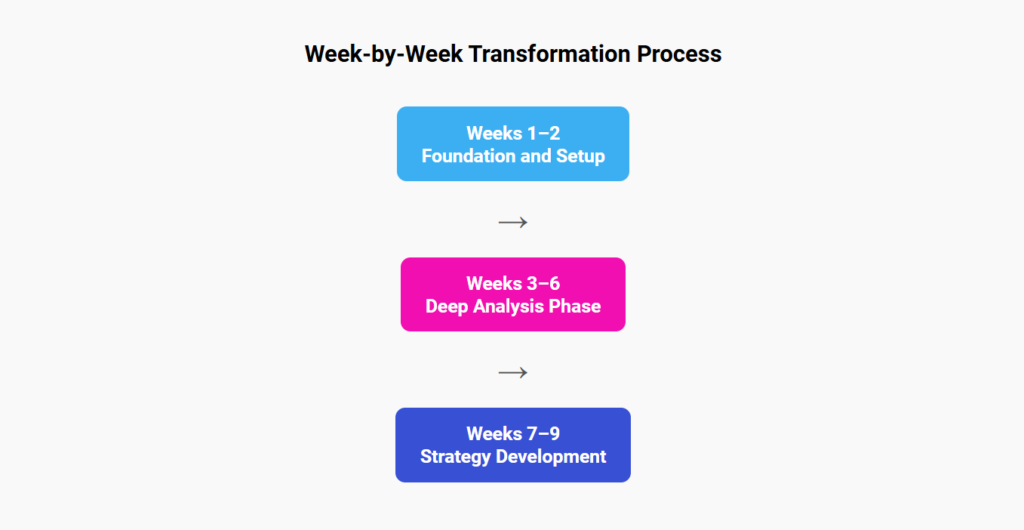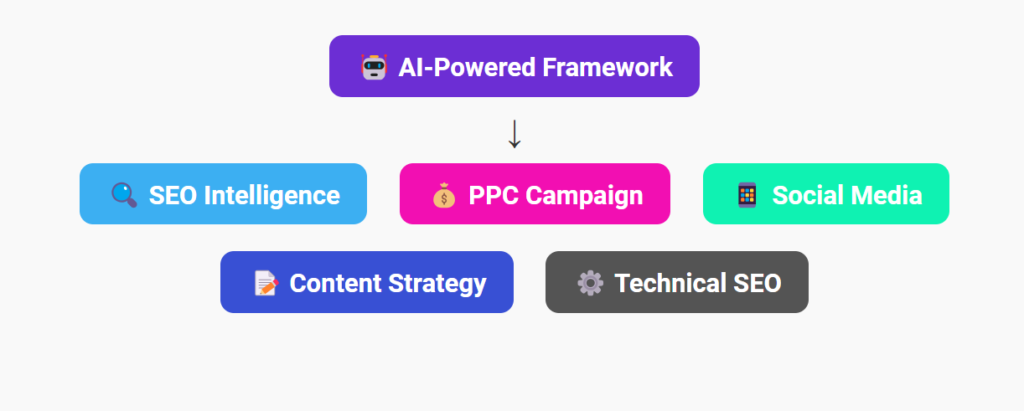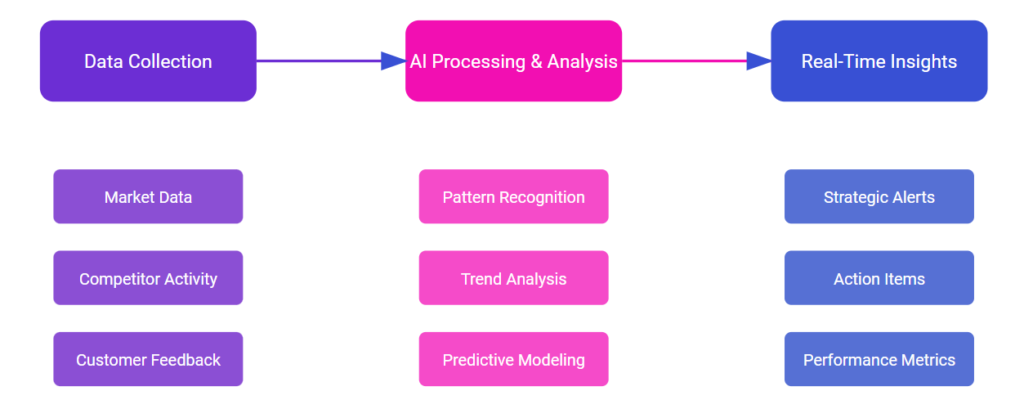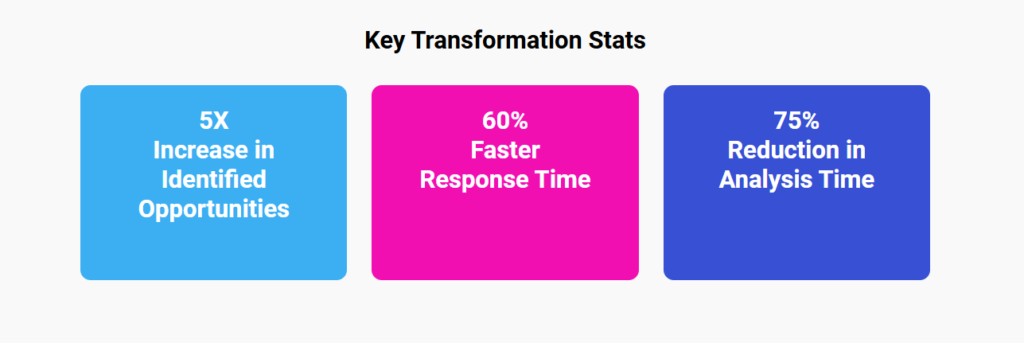From Data Overload to Actionable Intelligence in Weeks
“We’ve been working with agencies for six years, but we still don’t truly understand our competitive landscape.”
These were the frustrated words of a global B2B company’s CEO during our first meeting. Despite investing substantial resources in traditional competitor analysis methods and working with a respected marketing agency for over half a decade, they were still flying blind in an increasingly complex market. Their story isn’t unique – it’s a challenge facing countless B2B organizations trying to navigate today’s rapidly evolving business landscape.
Within weeks of adopting our AI framework, they slashed their competitive analysis time by 75%, uncovered 5× more opportunities than any traditional approach had revealed, and began responding to market changes 60% faster.
The Hidden Cost of Manual Competitor Analysis
Imagine spending six years and significant resources on competitive analysis, only to realize you’re still missing critical market opportunities and emerging threats. This was the reality for our client, a global B2B leader in its category before they transformed their approach with AI-powered competitive intelligence.
Their situation highlights three critical challenges that plague traditional competitor analysis methods:
1. The Global Competitor Identification Paradox
In today’s interconnected markets, competition isn’t just about identifying direct rivals. Our client discovered this the hard way when an indirect competitor from an adjacent industry captured 15% of their market share before being identified as a threat. Traditional analysis methods, focused on obvious competitors, had failed to flag this emerging player.
This challenge is particularly acute in B2B markets where:
- Competition spans multiple industries and geographies
- New players can emerge from unexpected sectors
- Traditional industry boundaries are increasingly blurred
- Digital transformation creates new competitive threats daily
2. The Data Paralysis Problem
The irony was stark: our client had access to more competitive data than ever before, yet struggled to extract meaningful insights. Their team was drowning in information spread across:
- Multiple SEO and analytics platforms
- Various social media channels
- Industry reports and market analyses
- Customer feedback and sales data
Manual analysis of this data mountain was not just time-consuming – it was impossible to maintain accuracy and consistency. Critical insights were being buried under an avalanche of information.
3. The Resource Drain Reality
Perhaps most concerning was the hidden cost of their traditional approach. The company was spending:
- Countless hours on manual data gathering
- Significant budget on consulting services
- Valuable team resources on report compilation
- Time they couldn’t afford in a fast-moving market
Yet despite these investments, they were still missing crucial market movements and competitor strategies.
The AI Transformation Turning Point
Everything changed when we introduced our AI-powered competitive analysis framework. Within weeks—not years—the company achieved:
- Clear visibility into their actual competitive landscape
- Real-time insights into market movements
- Actionable intelligence for strategic decisions
But before diving into how we achieved this transformation, let’s examine why traditional methods are leaving so many B2B companies in the dark.
Traditional methods of competitive analysis are failing modern B2B companies on multiple fronts. Manual data collection is overwhelmed by the sheer volume and velocity of market changes. Quarterly reports become outdated before they’re even completed. Siloed analysis misses crucial cross-channel patterns. Even when insights are discovered, the lag time between identification and action often renders them obsolete. Most critically, traditional approaches focus on obvious competitors and known market dynamics, leaving businesses vulnerable to disruption from unexpected quarters – as our client learned when they lost 15% market share to an indirect competitor.
This is why AI isn’t just an upgrade—it’s a complete paradigm shift in competitive intelligence. Our framework addresses these fundamental limitations through continuous, multi-channel monitoring that captures both obvious and subtle market signals. Instead of periodic snapshots, AI provides real-time analysis across vast datasets, identifying patterns and connections that human analysts might miss. The system doesn’t just collect data—it contextualizes it, prioritizes insights based on business impact, and automatically alerts relevant stakeholders when action is needed. Most importantly, our AI framework learns and adapts, becoming more accurate and insightful over time as it processes more industry-specific data and understands your unique competitive landscape.
Is your team maximizing the power of AI, or leaving revenue on the table?
Uncover your AI maturity with our free B2B Sales & Marketing Readiness Assessment.
Learn exactly where you can boost productivity, close more deals, and stay ahead of the competition.
From Insights to Action: Implementing AI-Powered Competitive Analysis
The transition from traditional methods to AI-powered competitive analysis might seem daunting, but we’ve developed a systematic approach that delivers results in weeks, not years. Here’s how we transformed our global B2B client’s competitive intelligence capabilities:

The Week-by-Week AI Transformation
When our global B2B client started their AI transformation journey, they were skeptical about the promised “weeks, not years” timeline. Here’s how we delivered on that promise:
Weeks 1–2: Foundation and Setup
Our initial phase focused on the rapid deployment of essential tools:
- SEMrush integration for baseline competitor data
- Custom AI assistant configuration tailored to their industry
- Data source connection and validation
- Initial competitive landscape snapshot
Key Win: Within 72 hours, our AI system identified three emerging competitors that traditional analysis had overlooked.
Weeks 3–6: Deep Analysis Phase
With the foundation in place, our AI assistants began generating actionable insights:
- Competitor Authority Score gap analysis
- Content strategy pattern recognition
- Market positioning evaluation
- Customer sentiment analysis
Real Result: We uncovered a significant market opportunity worth $2M in potential revenue through AI-powered pattern analysis of competitor weaknesses.
Weeks 7–9: Strategy Development
Transforming insights into action:
- AI-generated battlecards for sales teams
- Prioritized opportunity roadmap
- Resource allocation recommendations
- Risk mitigation strategies
Measured Impact: AI assistants identified 500% more competitive insights compared to traditional manual analysis.
Making AI Insights Actionable
The key to our success wasn’t just gathering better data – it was making that data immediately actionable:
Automated Priority Alerts
- Real-time competitor movement detection
- Threat level assessment
- Opportunity scoring
- Action recommendation generation
Customized Reporting Workflows
Each stakeholder receives tailored insights:
- Executive Team: Strategic movement alerts
- Sales: Real-time competitive intelligence
- Marketing: Content gap analysis
- Product: Feature comparison updates
Continuous Optimization
Our AI system learns and improves through:
- Win/loss analysis
- Pattern recognition refinement
- Strategy effectiveness tracking
- Market response monitoring
Measurable Results in the First Quarter
The transformation delivered clear, measurable results:
- 75% reduction in analysis time
- 5X increase in identified opportunities
- 60% faster response to market changes
Inside Our AI-Powered Framework: The Power of 50 Custom AI Assistants
Behind this transformation lies our powerful framework of 50 specialized AI assistants, each designed to tackle specific aspects of competitive analysis. Here’s the architecture of our solution:

Let’s look under the hood of our key AI assistants:
SEO Intelligence Assistants
Our SEO-focused AI tools provide deep insights into competitor positioning:
- Authority Score Analyzer tracks weekly changes and identifies link-building opportunities
- Keyword Strategy Optimizer uncovers high-ROI keyword opportunities and generates actionable content recommendations
PPC Campaign Intelligence
Dedicated AI assistants monitor and analyze paid advertising strategies:
- Ad Copy Analyzer monitors competitor ad variations and identifies high-performing elements
- Budget Allocation Assistant predicts competitor spend patterns and identifies market opportunity gaps
Social Media Insight Engine
Social-focused AI tools track competitor engagement and audience growth:
- Content Performance Tracker analyzes engagement patterns and identifies viral content triggers
- Competitive Benchmark Assistant compares engagement rates and tracks share of voice
Content Strategy Intelligence
Content-focused assistants ensure your strategy stays ahead:
- Gap Analysis Assistant identifies underserved topics and spots emerging content trends
- Topic Cluster Optimizer maps competitor content structures and identifies authority-building opportunities
Technical SEO Enhancement
Technical AI tools maintain your competitive edge:
- Schema Markup Optimizer identifies rich snippet opportunities and suggests improvements
- Site Health Monitor tracks technical issues and predicts performance impacts
Each assistant delivers:
- Real-time monitoring and alerts
- Predictive insights based on pattern recognition
- Actionable recommendations for immediate implementation
- Performance tracking and ROI measurement
Even operating independently, these AI tools have enabled our framework to identify 500% more competitive insights compared to traditional manual analysis. The success of this initial phase has proven the value of AI in competitive analysis, setting the stage for our next evolution: building an integrated AI Agents Workforce leveraging the Relevance AI platform. This upcoming integration will transform these individual tools into a seamlessly coordinated team of AI agents, multiplying their effectiveness through intelligent collaboration and automated insight sharing.
How to Leverage The Power of AI in Gaining Real-Time Market Insights
The transformation from traditional competitive analysis to AI-powered real-time insights isn’t just about implementing new tools – it’s about fundamentally reimagining how we monitor and respond to market movements. Our proven approach combines three critical elements:

As illustrated in the process flow above, our framework creates a seamless pipeline from data collection through AI processing to actionable insights. This systematic approach helps identify the most significant competitive signals and patterns while maintaining the speed and accuracy that modern B2B markets demand.
The power of AI-driven market insights begins with comprehensive data integration. Our framework aggregates and analyzes:
This integrated approach enables our AI assistants to identify patterns and correlations that would be impossible to detect manually, leading to that 500% increase in competitive insights we consistently observe.
Real-Time Processing Architecture
The key to maintaining a 60% faster response to market changes lies in our real-time processing architecture. This system:
- Continuously monitors competitor movements across all channels
- Instantly analyzes new market data against historical patterns
- Automatically adjusts significance thresholds based on market volatility
- Generates immediate alerts for critical competitive changes
Actionable Intelligence Distribution
Converting insights into action requires more than just data – it demands context and prioritization. Our framework achieves this through:
- Customized insight delivery based on stakeholder roles
- Automated action recommendation generation
- Priority-based alert systems
- Impact assessment scoring
This structured approach to intelligence distribution has been crucial in achieving the 75% reduction in analysis time while simultaneously increasing the quality and relevance of competitive insights.
Future Vision: AI Agents Workforce
As we look ahead, the evolution of our 50 specialized AI assistants into a unified workforce powered by the Relevance AI platform marks the beginning of an even more powerful approach to competitive analysis. This transformation elevates our current framework of independent AI tools into an interconnected workforce of AI agents, working in concert to deliver unprecedented market intelligence.
The AI Agents Workforce represents a fundamental shift in how competitive analysis operates. Instead of tools working in parallel, these agents collaborate intelligently, sharing insights and building upon each other’s findings in real-time. This interconnected approach means that insights discovered by one agent immediately inform and enhance the analysis of others, creating a multiplier effect that further accelerates our already impressive metrics.
Key advantages of this next-generation framework include:
Dynamic resource allocation, where agents automatically redistribute workloads based on market activity and priority. Intelligent insight synthesis, combining findings from multiple specialized agents to identify complex market patterns. Predictive optimization, where the workforce continuously refines its analysis based on outcome data and emerging market trends.
Early implementations of this system have shown promising results, with pilot programs demonstrating potential for doubling our current efficiency gains. As we continue to refine and expand this AI Agents Workforce, we expect to see even greater improvements in both the speed and depth of competitive analysis.
The future of B2B competitive analysis isn’t just about better tools – it’s about creating an intelligent, adaptive system that evolves with your business needs and market dynamics.
Why AI-Driven Tools Are Essential
Conclusion: Embracing the AI-Powered Future of Competitive Analysis
The journey from traditional competitive analysis to AI-powered intelligence represents more than just a technological upgrade – it’s a fundamental transformation in how businesses understand and respond to their market environment. Through our work with global B2B leaders, we’ve seen this transformation consistently deliver remarkable results: a 75% reduction in analysis time, 5X increase in identified opportunities, and 60% faster response to market changes.

But perhaps the most significant impact lies beyond these metrics. The shift to AI-powered competitive analysis enables organizations to move from reactive to predictive positioning. Where traditional methods struggled with data overload and missed crucial market signals, AI assistants now provide clear, actionable intelligence that drives strategic decision-making.
As we look ahead, the evolution toward an AI Agents Workforce promises even greater capabilities. This next generation of competitive analysis won’t just process more data – it will fundamentally change how businesses detect, analyze, and act on market opportunities.
The competitive landscape will continue to grow more complex, and the ability to rapidly analyze and act on market intelligence will increasingly separate market leaders from followers. For businesses ready to transform their competitive analysis capabilities, the time to act is now.
Ready to Transform Your Competitive Analysis? Schedule a demonstration to see how our AI-powered framework can revolutionize your market intelligence capabilities. Our team will show you exactly how we achieve these results and help you understand the potential impact for your organization.
